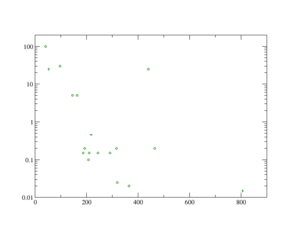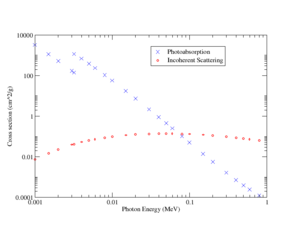Difference between revisions of "Gamma Emission"
| (One intermediate revision by the same user not shown) | |||
| Line 7: | Line 7: | ||
| − | the figures show that the highest intensity is for the photon of energy of 42 keV, and the rest of the relative intensities for the other energies are below 26 percent. | + | the figures show that the highest intensity is for the photon of energy of 42, 54, and 440 keV, and the rest of the relative intensities for the other energies are below 26 percent. If U-233 emits a photon that carries one of the energies mentioned above, and travels through a 1 cm wide region of Ar/CO2 gas, it will transit the drift region up to 99.96%, but within 0.04 % it may interact with Ar/CO2 gas by photoabsorption according to G4 simulation, and when an interaction happens, an electron leaves the atom carrying almost the same as the photon energy, its primary, secondary, and number of photons that are combined will be estimated by the previous simulations for beta particles. |
Latest revision as of 00:29, 4 April 2015
Photoabosrption and Scattering
U-233 emits gamma particles that interact with Ar/CO2 gas. U-233 emits gamma particles in the range as it is inside the gaseous chamber, the energy range for those gammas is 42 keV to 807 keV. (Ref.) the figures below show the expected photon interactions in Ar/CO2 90/10 and the relative intensity for emitting them,
the figures show that the highest intensity is for the photon of energy of 42, 54, and 440 keV, and the rest of the relative intensities for the other energies are below 26 percent. If U-233 emits a photon that carries one of the energies mentioned above, and travels through a 1 cm wide region of Ar/CO2 gas, it will transit the drift region up to 99.96%, but within 0.04 % it may interact with Ar/CO2 gas by photoabsorption according to G4 simulation, and when an interaction happens, an electron leaves the atom carrying almost the same as the photon energy, its primary, secondary, and number of photons that are combined will be estimated by the previous simulations for beta particles.

